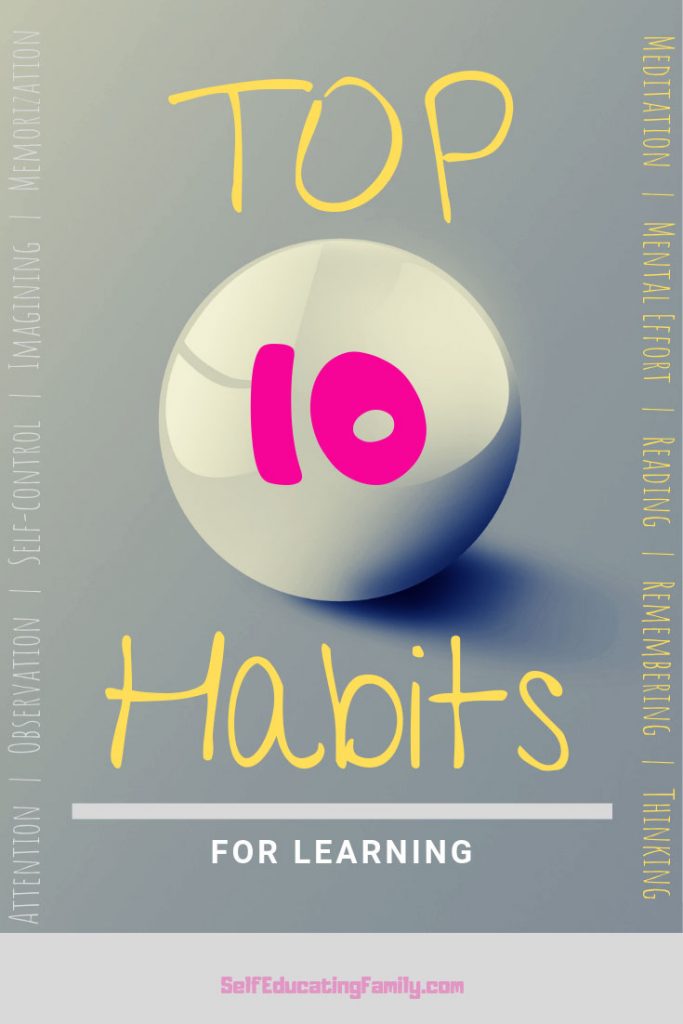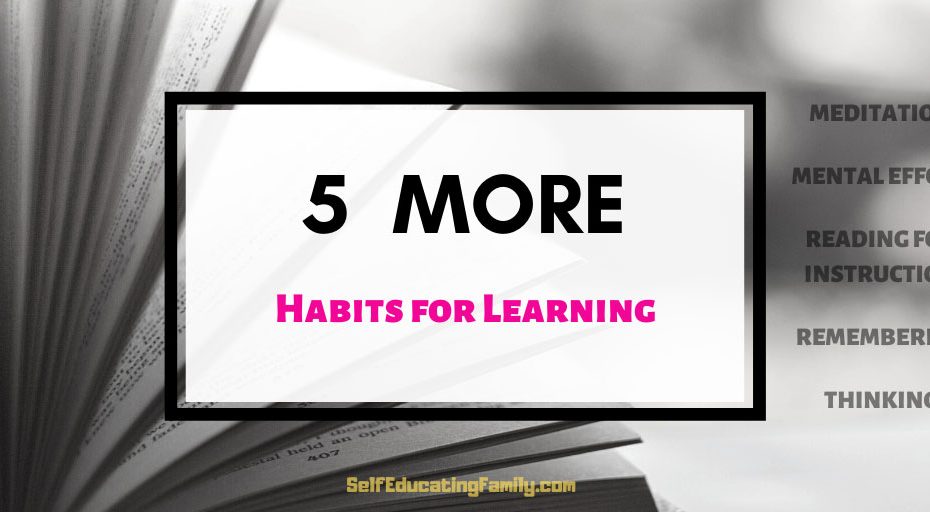What’s Inside: Advanced learning habits include meditation, mental effort, reading for instruction, remembering, and thinking. The post is a part of the series on The Top 10 Habits for Learning.
Part 3— of Top 10 Habits for Learning: the Advanced Habits
Welcome to Day 3 of looking at my favorite top 10 habits for learning! Today, we look at advanced learning habits.
In case you missed it, here are the first two parts of this series:
- 1: Overview of Top 10 Habits for Learning
- 2: Build the Foundation: Basic Habits for Learning
- 3: Grow Your Brain: Advanced Habits for Learning (this article)
- Ultimate Resource Roundup for Habits for Learning
In Part 2, we looked at the foundational habits of attention, observation, self-control, imagining, and memorization. And finally, today we will build on that foundation with the more advanced habits for learning: meditation, mental effort, reading for instruction, remembering, and thinking.
First, Recap of the Top 10
Here are my top 10 habits to acquire to be a better learner.
- Attention
- Observation
- Self-control
- Imagining
- Memorization
- Meditation
- Mental effort
- Reading for instruction (vs. just loving to read)
- Remembering
- Thinking
Why “Advanced” Learning Habits?
I’m differentiating the first 5 habits from my second 5 of “advanced” learning habits because it takes a more mature learner to be able to acquire these advanced habits.
For instance, you can work with young children, even as young as babies or toddlers, on the habit of attention. According to Helen Neville, author of Is This a Phase? Child Development & Parent Strategies, Birth to 6 Years, by playing games with or talking to a toddler about their activities, you can increase their attention span. Be sure not to have “interruptive” behaviors—use your observation skills to interact!
Compare attention with the habit of “reading for instruction.” It’s the rare toddler who pulls out a copy of How to Shoot Great Photographs with Any Camera.
We’ll get into this concept of “advanced” habits for learning as we look at each one in detail.
What Follows: Advanced learning habits
We’ll take a look at each of these advanced learning habits: meditation, mental effort, reading for instruction, remembering, and thinking. I’ll define what I mean by each one, including some resources I have found useful in learning to develop these habits.
Remember, habit development takes time. And it’s a good idea to work on just one habit at a time. Build the foundation first, then as you are ready, work on habits that build on an established habit next.
Who’s Ready for some Advanced Learning Habits?
It’s important to realize these advanced habits are appropriate for a learner who has hit certain maturity levels. And each habit is different. Some kids may be ready for reading for instruction as early as age 10 or 12—for example, the kid who is great at figuring out how things work. This kind of kid has probably be devouring non-fiction picture books for a long time. On the other hand, I know some adults who can’t read an instruction manual. But are they actually “not able to” or is it that they haven’t ever really tried to apply themselves?
You’ll have to decide which habits to start with and which you are ready for. Be sure you have the basic habits firmly established.
Examples of natural progressions
The first order I’m going to suggest is the order that I’ve listed these 10 habits in. The basics, then the ones that build on the others. Meditation is needed to digest information and experiences and may be useful to start working on earlier. It’s when many connections are happening. Jump down to the section on meditation for more detail.
If you want to work on “mental effort” first, then it’s a good follow up to attention and self-control. A young person needs to be able to direct their will towards their own learning. Every person will have some subjects which require more mental effort than others that’ll be unique to them. Use those times to practice mental effort habits. And be sure to break up your learning with short lessons.
Memorization and remembering are linked, obviously. Younger children readily memorize all kinds of information (e.g. think of children’s songs), but the brain has to be matured to start making the connections needed for remembering. Classical education theorists might equate this to the dialectic stage – pre-teen or so – when a youth is ready to ask those logic questions. Thinking, then, follows closely on the heels of remembering and mental effort.
Whatever order you choose to learn these habits in, even if you “work on” one habit at a time, the other related habits will also grow. That’s called tangential learning!
Habits 1-5
Before learning about the advanced habits, I recommend mastering the foundational habits of attention, observation, self-control, imagining, and memorization discussed here.
6. Meditation

Meditation: the process of surrendering all the powers of the mind to the occupation of the subject in hand in order to digest the information.
With meditation, we move into habits for the older or more mature learner.
What exactly is meditation?
When we hear the word meditation, we immediately think of the traditional image of sitting quietly cross-legged with our eyes closed.
While that type of meditation is extremely useful for learning, I’m talking about something slightly different, but equally useful.
“Scientists agree that your brain is a trainable ‘muscle’ that needs daily exercise. Around for millenia, more and more neuroscientific research points to meditation as being the very best brain exercise for learning.”
meditation will increase your capacity for learning: EOC Institute
Charlotte Mason-style meditation
“Meditation is also a habit to be acquired, or rather preserved, for we believe that children are born to meditate, as they are to reflect; indeed, the two are closely allied. In reflecting we ruminate on what we have received. In meditating we are not content to go over the past, we allow our minds to follow out our subject to all its issues… Intellectual progress, too, depends, not on mere reading or the laborious getting up of a subject which we call study, but on that active surrender of all the powers of the mind to the occupation of the subject in hand, which is intended by the word meditation.”
Charlotte Mason, School Education: Volume 3 of the Charlotte Mason Series, p. 121.
So we see that learning occurs, not just by reading or studying, but by thinking about what we are learning, a.k.a., meditation. It’s like chewing your food thoroughly for better digestion.
According to Dr. Benjamin E. Bernier, in an article on Charlotte Mason Poetry, “The doctrine of education as the nourishment of ideas naturally implies the need for a regular process by which these ideas may be received and digested. This process Mason identified as meditation.”
Meditation as digestion
Meditation is the digestion process of ALL the great ideas that you serve to your children. Keep in mind that digestion takes time. You have to build in “meditation time” into your schedule – or just time where nothing else happens but thinking about what you are learning. Even plain “quiet time” allows the process to happen.
You can also schedule nature study as another good tool to use where the process can flourish.
Resources for Nature Study
To begin with, here’s a thought-provoking take on using nature study for mindfulness in “Mindful Charlotte Mason” by Carrie Chauhan.
Nature study has a lot of built in quiet time that helps get better at meditation. Here are some tips on how to work nature study by Michelle Dawn in a guest post at Afterthoughts.
7. Mental effort

Mental Effort: Exerting oneself to apply the mind
Connection between attention and mental effort
Again, mental effort should be considered a more advanced habit that directly relates to attention. While you should be able to begin training a young child in the habit of attention, you probably would wait until you saw a certain maturity before working on deliberately training the habit of mental effort.
So, let’s examine the difference between attention and mental effort by looking at what CM wrote:
“As for all the teaching in the nature of ‘told to the children,’ most children get their share of that whether in the infant school or at home, but this is practically outside the sphere of that part of education which demands a conscious mental effort, from the scholar, the mental effort of telling again that which has been read or heard. That is how we all learn, we tell again, to ourselves if need be, the matter we wish to retain, the sermon, the lecture, the conversation. The method is as old as the mind of man, the distressful fact is that it has been made so little use of in general education.”
Volume 6 page 160 from the CM Series
Narration as a tool for mental effort
So we see that “Mental Effort” is cultivated through the use of narration according to CM. For some narration resources with a free infographic on the basics of Charlotte Mason-style narration see my guest post that I wrote for the Unexpected Homeschooler. The post lists top resources for the how-to’s of narration at the bottom and discusses potential challenges that can come up.
If you’d like to see a discussion group analyzing Chapter 7 of Karen Glass’ book Know & Tell, see what my book club had to say about this excellent resource on narration.
Interestingly, Anne at Language Learning at Home applies the habit of mental effort into learning a foreign language and how learning that language actually makes the habit stronger.
Another aspect of mental effort to consider is speed. I’m talking about plodding through lessons as compared to focusing oneself to execute quickly. And this is relative to the student’s usual speed. You aren’t making every child get every lesson done in 5 minutes. It depends on the child and on the lesson. You can usually tell the difference between dawdling and focus.
“Rapid Mental Effort––The habits of mental activity and of application are trained by the very means employed to cultivate that of attention. The child may plod diligently through his work who might be trained to rapid mental effort. The teacher herself must be alert, must expect instant answers, quick thought, rapid work. The tortoise will lag behind the hare, but the tortoise must be trained to move, every day, a trifle quicker. Aim steadily at securing quickness of apprehension and execution, and that goes far towards getting it.”
Charlotte Mason, Home Education: Volume 1 p. 150
Rapid work and Math
It’s natural to work towards rapid execution in mathematics. Automaticity of math facts, for instance, can just make everything easier. However, some kids have a tendency to dawdle in this area, and if allowed to dawdle all the time, then dawdling becomes the habit. Why not train the opposite?
Catherin Aday from Spreading the Feast discusses how she revamped her approach to math lessons using Richele Baburina’s book, Mathematics: An Instrument for Living Teaching. Catherine gives and in-depth review of how she changed the atmosphere in her home to “delighting in the beauty of the mathematical world … with mental sharpness and agility.”
Sonya Shafer of Simply Charlotte Mason talks to the author of that book just mentioned, Richele Baburina, about her 10 years of using CM methods to teach math. Sonya also sells the book in her store, along with a DVD.
8. Reading for instruction (vs. simply loving to read)
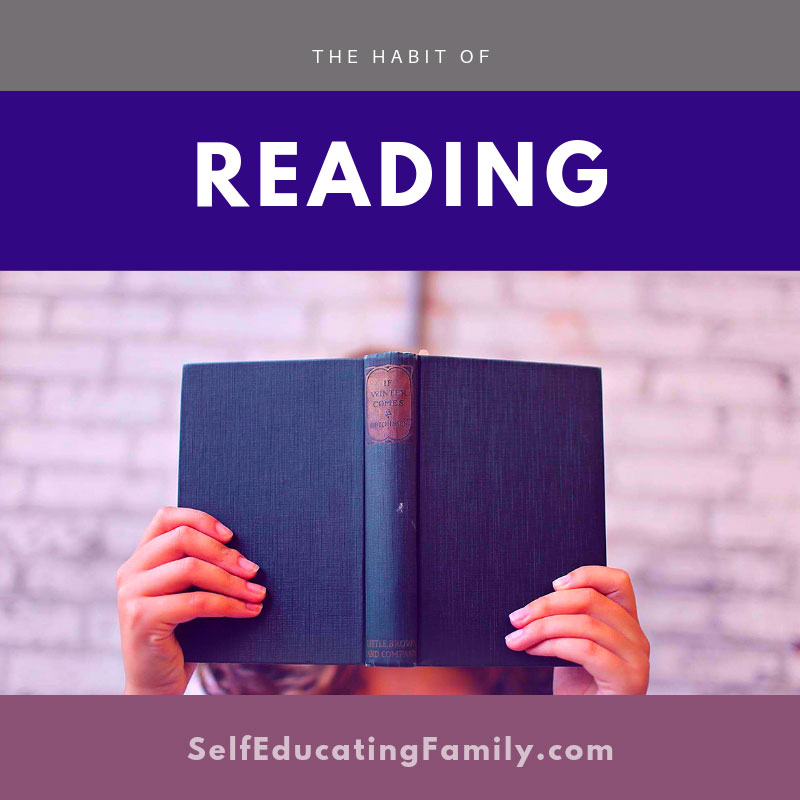
What is Reading for Instruction?
CM recommends having children younger than 6 learning about their world through ample outdoor play, nature walks, and guided oral questions from the parent about observations. If you have children with a broad age range, and you are reading a history lesson together, younger than 6 is not the time to begin quizzing the youngest children on what they remember. Before age 6, the child uses his senses to obtain knowledge. After age 6, the notion of books as a resource of knowledge begins to take shape.
“This period of a child’s life between his sixth and his ninth year should be used to lay the basis of a liberal education, and of the habit of reading for instruction. During these years the child should enter upon the domain of knowledge, in a good many directions, in a reposeful, consecutive way, which is not to be attained through the somewhat exciting medium of oral lessons.”
Vol. 1 p 11 of the Charlotte Mason Series
The emphasis on reading books to learn is clear:
“Children should read books, not about books and about authors; this sort of reading may be left for the spare hours of the dilettante. Their reading should be carefully ordered, for the most part in historical sequence; they should read to know, whether it be Robinson Crusoe or Huxley’s Physiography; their knowledge should be tested, not by questions, but by the oral (and occasionally the written) reproduction of a passage after one reading; all further processes that we concern ourselves about in teaching, the mind performs for itself; and, lastly, this sort of reading should be the chief business in the class room.”
Towards A Philosophy of Education, Volume 6 of the Charlotte Mason Series, vol 6 pg 342
Living Books used for reading for instruction
One of Charlotte Mason’s 20 points of education was:
13. In devising a SYLLABUS for a normal child, of whatever social class, three points must be considered:
(a) He requires much knowledge, for the mind needs sufficient food as much as does the body.
(b) The knowledge should be various, for sameness in mental diet does not create appetite (i.e., curiosity)
(c) Knowledge should be communicated in well-chosen language, because his attention responds naturally to what is conveyed in literary form.
The Charlotte Mason Series
This “well-chosen language” refers to living books.
Resources for Habit of Reading for instruction
Usually from age 9 to 12, the child will transition to reading most of their lessons themselves. Be sure to keep listening or reading their narrations from their living books. Then later towards high school, the child will add in written narrations. At the same time, the child will likely transition from formal copywork to keeping a commonplace notebook. Some families continue to use both tools.
Most of the major contributors to the Charlotte Mason community have posts on living books and how to use them (like Simply Charlotte Mason, Afterthoughts, Pam Barnhill) or podcasts (Schole Sisters). Even the more general homeschooling resources give some good overviews (Homeschool Mom).
Here’s a few other resources. Dollie from the Charlotte Mason Way has some good lists and guides for living books.
Lastly, here’s a post from Homeschooling Down Under on living books.
9. Remembering
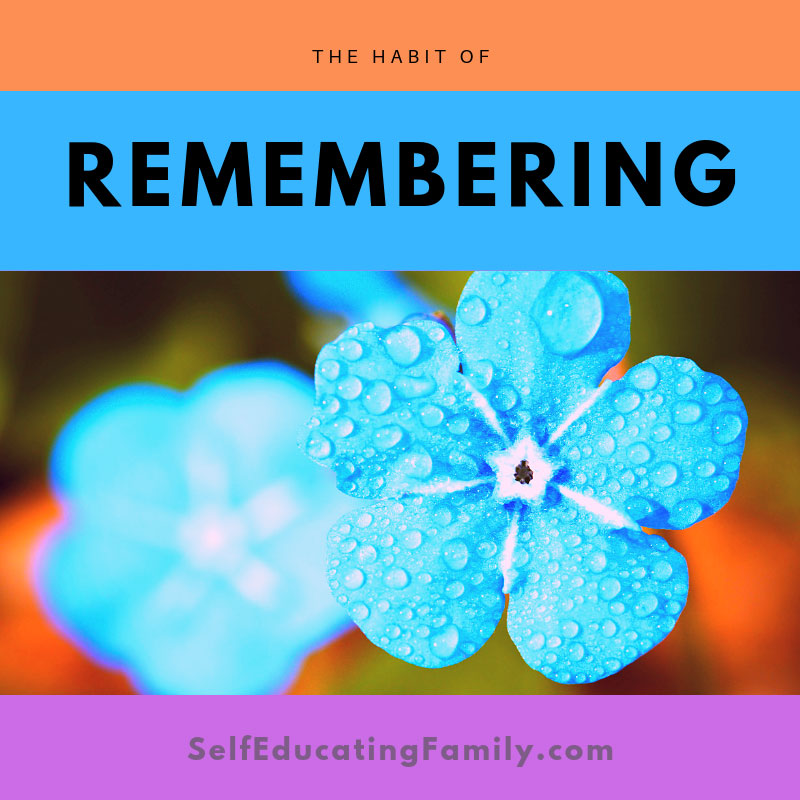
Why is Remembering and advanced learning habit?
In Volume 1: Home Education of Charlotte Mason Series (pp. 154—160), CM spends a section discussing the habit of remembering. Here’s an EXTREMELY brief summary of the section (some of the following are direct quotes):
CM discussion on remembering
- Remembering and Recollecting: “We remember what we have learned and can recollect it on demand”.
- A ‘Spurious’ Memory: “Cramming to learn allows knowledge to go into our brains briefly never to be heard from again.”
- Memory a Record in the Brain Substance: CM discusses how memory is formed, according to brain science theories at her time. She talks about the mind taking cognizance of facts and the nerve substance recording it to be preserved. Remember CM was actually alive 100 years before the Atkinson-Shiffrin memory model discussed long term vs. short term and working memory in 1968. Interestingly, CM expresses the gist of it, without using the words ‘long’ & ‘short’ term memory.
- Made under what conditions: Fixing attention on something can make the “impression” into memory. She likens this to a photographic memory for facts.
- Recollection and the Association of Facts: New facts have to be associated with ones you already know. She gives the example of learning French. You can learn a vocabulary word, but you have to associate it with the rest of the French language that you are learning. A single instance of the fact, doesn’t work – you need the associations. In modern lingo, appropriately spaced review of facts with review of existing knowledge helps them to cross over into long term memory.
- Every Lesson must recall the Last: This “interlaces” the knowledge.
- No Limit to the Recording Power of the Brain: You can keep learning new stuff, no limits with the caveat that “the path should be kept open by frequent goings and comings” to prevent loss of knowledge, such as being fluent in a foreign language when young and then forgetting it in old age because of disuse. Interestingly, modern neuroplasticity brain theory suggests the same thing.
- But Links of Association a Condition of Recollection: “The links of recollection depend on the subject you are learning.”
I always love finding ways that CM used for teaching children that are so in line with today’s brain theories!
Resources for Remembering
All in all, since narration is one of the best ways of making the “links of association” to recollect what goes into remembering what you learn, here are more resources for one of the best tools for self-learning: narration.
- My guest post on troubleshooting narration on The Unexpected Homeschooler (lots of resources at the bottom of page)
- Sonya Shafer at Simply Charlotte Mason on Narration Ideas
- Ambleside online summation of narration FAQ
- Randi at Nourished Children with complete how to narrate
- Lara at Everyday Graces on effective narration with podcast
- Julie at A Gentle Feast with a practical guide of why and how to narrate
10. Thinking
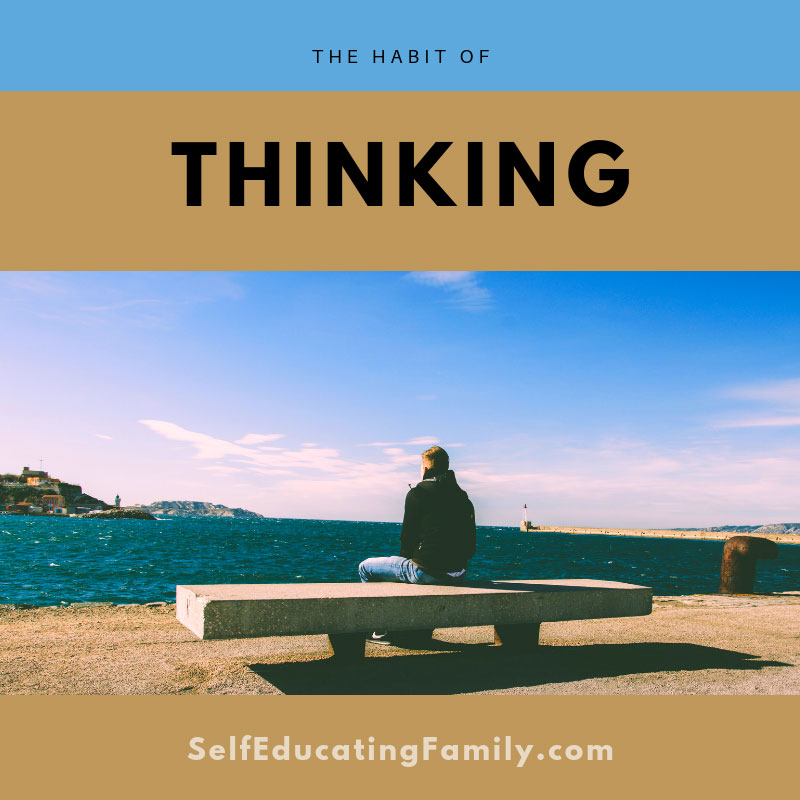
Thinking: a real conscious effort of mind
Specifically, with the habit of thinking, we really begin to tie all these “habits of the mind” together, in what I call these “advanced habits for learning”, as noted by Brandy at Afterthoughts.
Thinking takes practice
Just as mental effort needs the habit of attention, thinking needs the habit of mental effort. Or rather, in CM’s words, “Thinking comes by practice.” Home Education, Volume 1 of the Charlotte Mason Series, p. 153.
Thinking comes by practice.
Charlotte Mason
So with thinking, we begin to take the associations we see and learn to compare and contrast. Again, these are CM’s ideas—not mine. Learning to see cause and effect; making comparisons and seeing similarities and differences – this is where thinking happens.
In contrast, much of today’s worksheet-driven educational methodologies do not really make students think. Teaching to the test makes a student a very good test taker. I know – I was a taught to be a very good test taker, and I taught my sons how to do the same. But that doesn’t make that the ultimate goal of an education.
On the other hand, creating thinking creatures in a large classroom setting can create mayhem, so it’s harder and is, more often than not, the road not taken in education.
Did you see what I just did in those last two paragraphs? I compared test-driven education to CM principles of education and made a conclusion – I was practicing my thinking. And please don’t take offense if you are in the education world – so many great teachers are! I’m criticizing methodologies here. I think this way yields a more “thoughtful” (able to think) person.
And just how do we encourage thinking as a habit
Promoting thinking as an advanced habit
Does it start by not squelching that little questioner: “Why does the moon shape change?”
When your kiddo gets to the “Why” phase, CM suggests making the child turn over the why themselves for a bit. Ask them a question back, “Why do you think?” She thinks by letting them mull it over a bit helps them to learn to think. And by asking them why or how often, on your nature walks for instance, it helps them to keep practicing. You can give the “correct” answer if their thinking is way off – you don’t want your kid thinking the moon is made of cheese or whatever.
Resources for the habit of thinking
Here’s one more article that focuses specifically on the habit of thinking from Brandy at Afterthoughts.
Karen Glass, author of Consider This (among other books on CM methodology), explains “synthetic thinking” in her book and in this article. Synthetic thinking is relational. How does this thing I just learned fit in with all the other stuff I’ve learned? She explains it much better!
Nancy Kelly from Sage Parnassus discusses Charlotte Mason and raising critical thinkers in this article. In addition to a podcast, she’s got a lot of helpful articles on how to apply CM methods to today’s modern subjects, as well as the more advanced subjects like Plutarch and Shakespeare – both of which seriously help develop thinkers!
If you want some more on Shakespeare studies in a Charlotte Mason group, read this.
Also, here’s a great article on thinking and how it relates to learning by Scott Young.
Tools for Habits of the Mind
The following tools and subjects will aid in developing advanced habits for learning.
- Meditation –nature study
- Mental Effort—narration, foreign language, and math
- Reading for Instruction – living books and narration
- Remembering—narration and recitation
- Thinking—all of it!
There you have it: the advanced learning habits
Even though I separated this into 3 posts, this one is STILL too long! Here’s the navigation back to the other articles:
- 1: Overview of Top 10 Habits for Learning
- 2: Build the Foundation: Basic Habits for Learning
- 3: Grow Your Brain with Advanced Habits for Learning
Summary of Resources
Finally, all the resources for learning habits for learning compiled in this article and the earlier posts covering all 10 habits for learning can be found in the Ultimate Resource Roundup for Habits for Learning.
Recap of 10 habits to acquire to be a Better Learner
Finally, here are all 10 habits for learning:
- Attention
- Observation
- Self-control
- Imagining
- Memorization
- Meditation
- Mental effort
- Reading for instruction (vs. just loving to read)
- Remembering
- Thinking
Thanks for reading!
